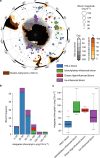Hydrothermal vents trigger massive phytoplankton blooms in the Southern Ocean
- PMID: 31165724
- PMCID: PMC6549147
- DOI: 10.1038/s41467-019-09973-6
Hydrothermal vents trigger massive phytoplankton blooms in the Southern Ocean
Abstract
Hydrothermal activity is significant in regulating the dynamics of trace elements in the ocean. Biogeochemical models suggest that hydrothermal iron might play an important role in the iron-depleted Southern Ocean by enhancing the biological pump. However, the ability of this mechanism to affect large-scale biogeochemistry and the pathways by which hydrothermal iron reach the surface layer have not been observationally constrained. Here we present the first observational evidence of upwelled hydrothermally influenced deep waters stimulating massive phytoplankton blooms in the Southern Ocean. Captured by profiling floats, two blooms were observed in the vicinity of the Antarctic Circumpolar Current, downstream of active hydrothermal vents along the Southwest Indian Ridge. These hotspots of biological activity are supported by mixing of hydrothermally sourced iron stimulated by flow-topography interactions. Such findings reveal the important role of hydrothermal vents on surface biogeochemistry, potentially fueling local hotspot sinks for atmospheric CO2 by enhancing the biological pump.
Conflict of interest statement
The authors declare no competing interests.
Figures




References
-
- Moore JK, Doney SC, Glover DM, Fung IY. Iron cycling and nutrient-limitation patterns in surface waters of the World Ocean. Deep Sea Res. 2001;2 49:463–507. doi: 10.1016/S0967-0645(01)00109-6. - DOI
-
- Boyd PW, Ellwood MJ. The biogeochemical cycle of iron in the ocean. Nat. Geosci. 2010;3:675. doi: 10.1038/ngeo964. - DOI
-
- Tagliabue A, et al. Hydrothermal contribution to the oceanic dissolved iron inventory. Nat. Geosci. 2010;3:252–256. doi: 10.1038/ngeo818. - DOI
-
- Tagliabue A, Aumont O, Bopp L. The impact of different external sources of iron on the global carbon cycle. Geophys. Res. Lett. 2014;41:920–926. doi: 10.1002/2013GL059059. - DOI
Publication types
MeSH terms
Substances
Grants and funding
LinkOut - more resources
Full Text Sources
Other Literature Sources

